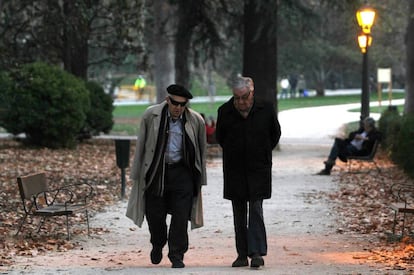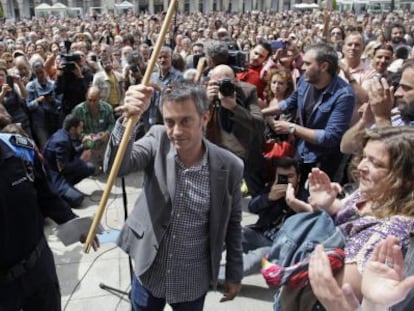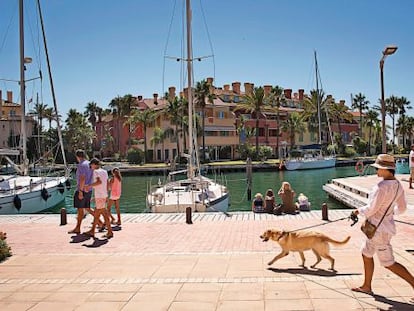For a third of Spanish households, a pension is the sole source of income
Latest National Statistics Institute report shows immigrant families’ income below national average


The latest data from the National Statistics Institute (INE) show that Spaniards are spending more on food and drink, whether at home or in bars and restaurants, and that consumption is driving what little growth the Spanish economy has shown in recent years.
Most households depend either on a monthly paycheck or self-employed earnings. But the INE’s figures show that for 34.3% of households in Spain, a pension – for retired, disabled or widowed individuals – is the main source of income.
A further 5.71% of households in Spain depend either on temporary unemployment benefits or welfare checks. The figure has fallen from a high of 6.8% in 2014; in 2006, prior to the crisis, the figure was 2.3%.
The INE’s figures show that for 34.3% of households in Spain, a pension is the main source of income
The number of salaried workers has risen to 47.12%, the highest level since 2011. What’s more, employees make up the biggest spenders, according to the INE’s data. The self-employed make up 10.5% of households, as they did last year.
How people earn their living has a big influence on how much money they spend. Households where the main breadwinner is working spent €31,095 last year, 13.4% higher than the average. Households where the main breadwinner was unemployed spent €17,461, 36% below the average. In the case of households dependent on a pension, the average annual budget is €25,319.
Nationality also influences spending, according to the INE’s figures. Non-Spaniards spend on average €20,331 a year, compared to the €28,066 Spanish households spend.
Sign up for our newsletter
EL PAÍS English Edition has launched a weekly newsletter. Sign up today to receive a selection of our best stories in your inbox every Saturday morning. For full details about how to subscribe, click here.
The area of spending that has grown the most since 2014 is drinking and dining out, with a 9.1% increase between 2014 and 2015.
Similarly, Spaniards spent €60 more in 2015 than the previous year – a 3.9% increase – on culture and entertainment, while there was a 6.8% increase in all-inclusive holidays, along with a 6% hike in sports equipment spending.
Broken down by regions, Basque families spent the most last year on average (€33,318), followed by Madrid (€31,532) and Navarre (€31,356). The lowest spending was recorded in Extremadura (€22,493), the Canary Islands (€23,372) and Andalusia (€24,342).
English version by Nick Lyne.
Tu suscripción se está usando en otro dispositivo
¿Quieres añadir otro usuario a tu suscripción?
Si continúas leyendo en este dispositivo, no se podrá leer en el otro.
FlechaTu suscripción se está usando en otro dispositivo y solo puedes acceder a EL PAÍS desde un dispositivo a la vez.
Si quieres compartir tu cuenta, cambia tu suscripción a la modalidad Premium, así podrás añadir otro usuario. Cada uno accederá con su propia cuenta de email, lo que os permitirá personalizar vuestra experiencia en EL PAÍS.
¿Tienes una suscripción de empresa? Accede aquí para contratar más cuentas.
En el caso de no saber quién está usando tu cuenta, te recomendamos cambiar tu contraseña aquí.
Si decides continuar compartiendo tu cuenta, este mensaje se mostrará en tu dispositivo y en el de la otra persona que está usando tu cuenta de forma indefinida, afectando a tu experiencia de lectura. Puedes consultar aquí los términos y condiciones de la suscripción digital.
More information
Archived In
Últimas noticias
Luisa Neubauer, climate change activist: ‘Ecology shouldn’t be a punitive force, but a joyful and liberating one’
Trump followed CIA recommendation to hand power to Delcy Rodríguez due to risk that Machado would not control the army
The Motherwell painting that Franco wanted to hide from view
Mexico seeks to shore up its defenses following US incursion in Venezuela
Most viewed
- Alain Aspect, Nobel laureate in physics: ‘Einstein was so smart that he would have had to recognize quantum entanglement’
- Alvin Hellerstein, a 92-year-old judge appointed by Bill Clinton, to preside over Maduro’s trial in New York
- Cuba confirms death of 32 of its citizens in the US attack against Venezuela
- Gilles Lipovetsky: ‘If you want to live better and fall in love, take Prozac, don’t look to philosophy’
- Why oil has been at the center of Venezuela-US conflicts for decades










































